fuel YAMAHA NMAX 125 2015 Owners Manual
[x] Cancel search | Manufacturer: YAMAHA, Model Year: 2015, Model line: NMAX 125, Model: YAMAHA NMAX 125 2015Pages: 90, PDF Size: 3.56 MB
Page 6 of 90

Table of contentsSafety information ............................ 1-1
Further safe-riding points ............... 1-5
Description ....................................... 2-1
Left view ......................................... 2-1
Right view ....................................... 2-2
Controls and instruments ............... 2-3
Instrument an d control functions ... 3-1
Main switch/steering lock............... 3-1
Keyhole shutter .............................. 3-2
Indicator lights and warning lights............................................ 3-2
Multi-function meter unit ................ 3-4
Handlebar switches ...................... 3-10
Front brake lever .......................... 3-10
Rear brake lever ........................... 3-11
ABS .............................................. 3-11
Fuel tank cap ................................ 3-12
Fuel ............................................... 3-13
Fuel tank overflow hose ............... 3-14
Catalytic converter ....................... 3-14
Seat .............................................. 3-15
Storage compartments................. 3-16
Sidestand ..................................... 3-17
Ignition circuit cut-off system ....... 3-17 For your safety – pre-operation
checks
............................................... 4-1
Operation an d important ri din g
points ................................................. 5-1
Starting the engine .......................... 5-1
Starting off ...................................... 5-2
Acceleration and deceleration ........ 5-2
Braking ............................................ 5-2
Tips for reducing fuel consumption ................................ 5-3
Engine break-in ............................... 5-3
Parking ............................................ 5-4
Perio dic maintenance an d
a d justment ........................................ 6-1
Owner’s tool kit ............................... 6-1
Periodic maintenance chart for
the emission control system ........ 6-2
General maintenance and
lubrication chart ........................... 6-3
Removing and installing panels ...... 6-7
Checking the spark plug ................. 6-8
Engine oil and oil strainer .............. 6-10
Final transmission oil..................... 6-12
Coolant.......................................... 6-13
Air filter and V-belt case air filter elements .................................... 6-16
Checking the throttle grip
free play ..................................... 6-18
Valve clearance ............................. 6-19 Tires .............................................. 6-19
Cast wheels .................................. 6-21
Checking the front and rear
brake lever free play .................. 6-21
Checking the front and rear
brake pads ................................ 6-22
Checking the brake fluid level ...... 6-22
Changing the brake fluid .............. 6-24
Checking the V-belt ...................... 6-24
Checking and lubricating the cables ........................................ 6-24
Checking and lubricating the throttle grip and cable ............... 6-25
Lubricating the front and rear
brake levers ............................... 6-25
Checking and lubricating the centerstand and sidestand........ 6-26
Checking the front fork ................. 6-26
Checking the steering................... 6-27
Checking the wheel bearings ....... 6-27
Battery .......................................... 6-28
Replacing the fuses ...................... 6-29
Headlight ...................................... 6-30
Replacing an auxiliary light bulb ........................................... 6-31
Brake light..................................... 6-32
Replacing the taillight bulb ........... 6-32
Replacing a front turn signal light bulb.................................... 6-34
Replacing a rear turn signal light bulb.................................... 6-35U2DSE0E0.book Page 1 Thursday, March 19, 2015 10:34 AM
Page 14 of 90
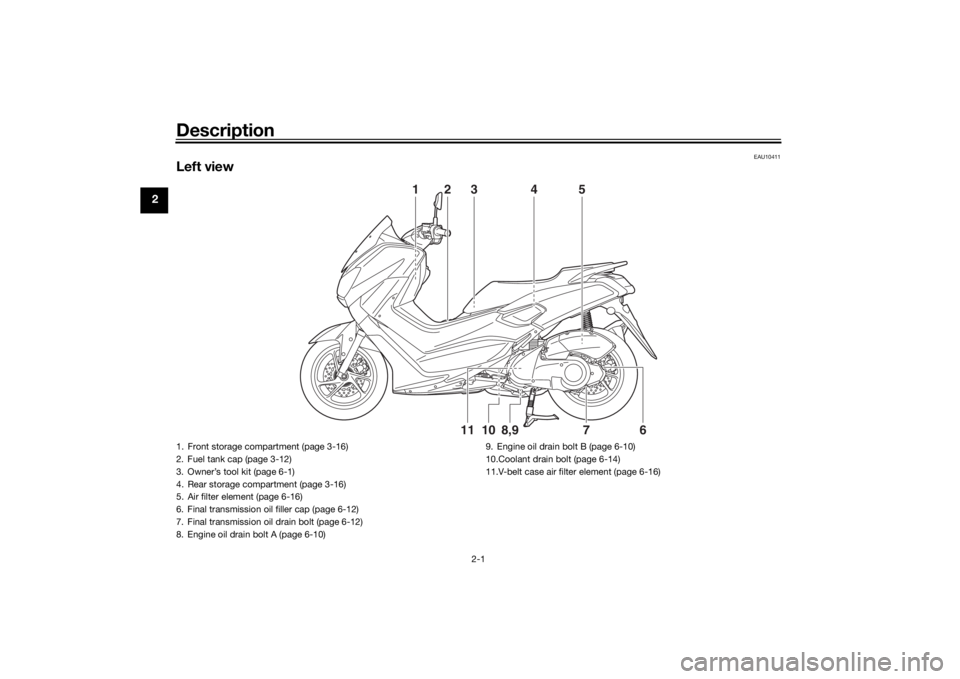
Description
2-1
2
EAU10411
Left view
6
7
8,9
10
11
123 4 5
1. Front storage compartment (page 3-16)
2. Fuel tank cap (page 3-12)
3. Owner’s tool kit (page 6-1)
4. Rear storage compartment (page 3-16)
5. Air filter element (page 6-16)
6. Final transmission oil filler cap (page 6-12)
7. Final transmission oil drain bolt (page 6-12)
8. Engine oil drain bolt A (page 6-10)
9. Engine oil drain bolt B (page 6-10)
10.Coolant drain bolt (page 6-14)
11.V-belt case air filter element (page 6-16)U2DSE0E0.book Page 1 Thursday, March 19, 2015 10:34 AM
Page 20 of 90
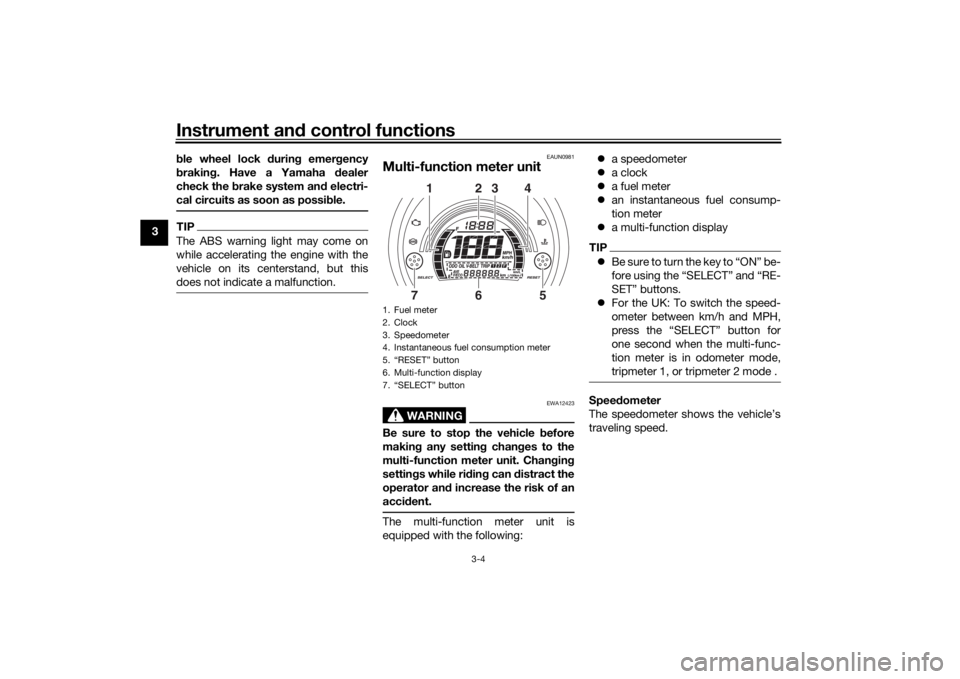
Instrument and control functions
3-4
3 b
le wheel lock during emer gency
b rakin g. Have a Yamaha d ealer
check the brake system an d electri-
cal circuits as soon as possi ble.
TIPThe ABS warning light may come on
while accelerating the engine with the
vehicle on its centerstand, but this
does not indicate a malfunction.
EAUN0981
Multi-function meter unit
WARNING
EWA12423
Be sure to stop the vehicle before
makin g any settin g chan ges to the
multi-function meter unit. Chan gin g
settin gs while ri din g can d istract the
operator an d increase the risk of an
acci dent.The multi-function meter unit is
equipped with the following:
a speedometer
a clock
a fuel meter
an instantaneous fuel consump-
tion meter
a multi-function display
TIPBe sure to turn the key to “ON” be-
fore using the “SELECT” and “RE-
SET” buttons.
For the UK: To switch the speed-
ometer between km/h and MPH,
press the “SELECT” button for
one second when the multi-func-
tion meter is in odometer mode,
tripmeter 1, or tripmeter 2 mode .Speed ometer
The speedometer shows the vehicle’s
traveling speed.
1. Fuel meter
2. Clock
3. Speedometer
4. Instantaneous fuel consumption meter
5. “RESET” button
6. Multi-function display
7. “SELECT” button
2
3
1
4
6
7
5
U2DSE0E0.book Page 4 Thursday, March 19, 2015 10:34 AM
Page 21 of 90
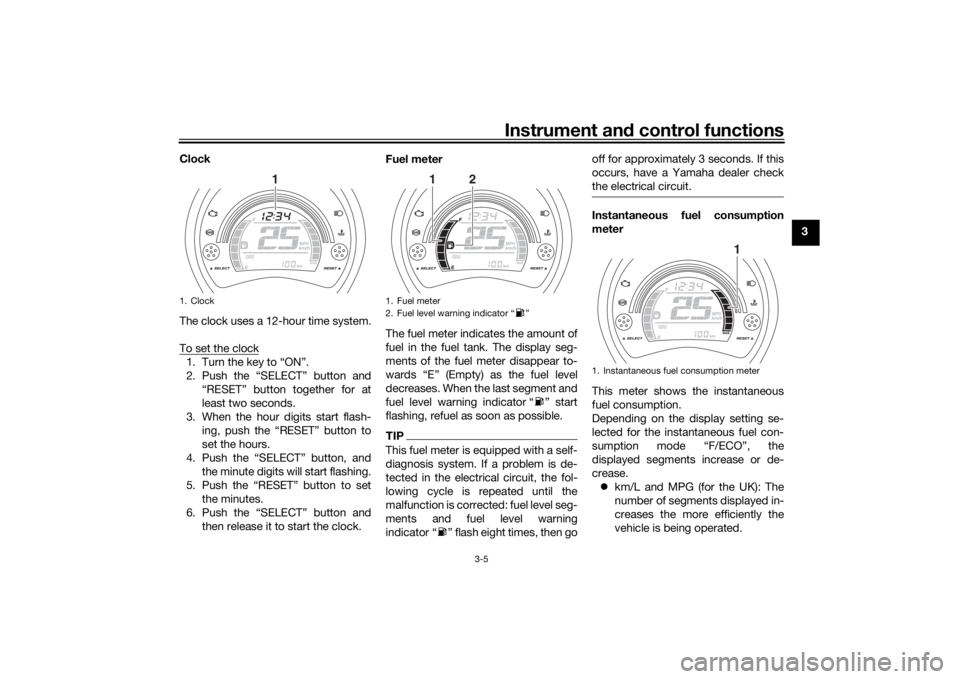
Instrument and control functions
3-5
3
Clock
The clock uses a 12-hour time system.
To set the clock
1. Turn the key to “ON”.
2. Push the “SELECT” button and
“RESET” button together for at
least two seconds.
3. When the hour digits start flash- ing, push the “RESET” button to
set the hours.
4. Push the “SELECT” button, and the minute digits will start flashing.
5. Push the “RESET” button to set the minutes.
6. Push the “SELECT” button and then release it to start the clock. Fuel meter
The fuel meter indicates the amount of
fuel in the fuel tank. The display seg-
ments of the fuel meter disappear to-
wards “E” (Empty) as the fuel level
decreases. When the last segment and
fuel level warning indicator “ ” start
flashing, refuel as soon as possible.
TIPThis fuel meter is equipped with a self-
diagnosis system. If a problem is de-
tected in the electrical circuit, the fol-
lowing cycle is repeated until the
malfunction is corrected: fuel level seg-
ments and fuel level warning
indicator “ ” flash eight times, then go off for approximately 3 seconds. If this
occurs, have a Yamaha dealer check
the electrical circuit.
Instantaneous fuel consumption
meter
This meter shows the instantaneous
fuel consumption.
Depending on the display setting se-
lected for the instantaneous fuel con-
sumption mode “F/ECO”, the
displayed segments increase or de-
crease.
km/L and MPG (for the UK): The
number of segments displayed in-
creases the more efficiently the
vehicle is being operated.
1. Clock
1
1. Fuel meter
2. Fuel level warning indicator “ ”
1
2
1. Instantaneous fuel consumption meter
1
U2DSE0E0.book Page 5 Thursday, March 19, 2015 10:34 AM
Page 22 of 90
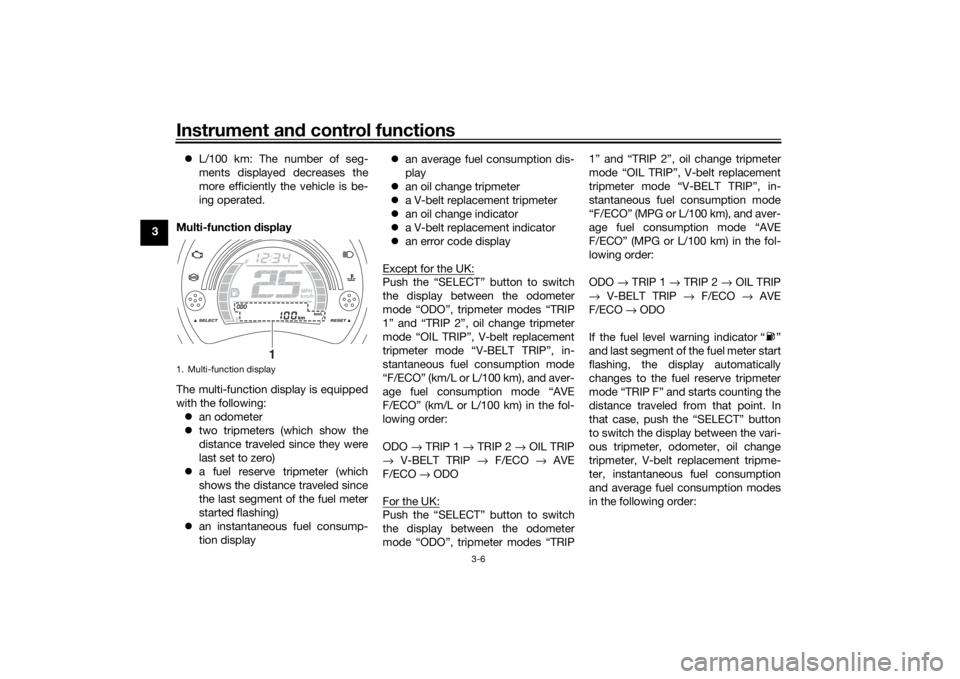
Instrument and control functions
3-6
3
L/100 km: The number of seg-
ments displayed decreases the
more efficiently the vehicle is be-
ing operated.
Multi-function display
The multi-function display is equipped
with the following: an odometer
two tripmeters (which show the
distance traveled since they were
last set to zero)
a fuel reserve tripmeter (which
shows the distance traveled since
the last segment of the fuel meter
started flashing)
an instantaneous fuel consump-
tion display
an average fuel consumption dis-
play
an oil change tripmeter
a V-belt replacement tripmeter
an oil change indicator
a V-belt replacement indicator
an error code display
Except for the UK:
Push the “SELECT” button to switch
the display between the odometer
mode “ODO”, tripmeter modes “TRIP
1” and “TRIP 2”, oil change tripmeter
mode “OIL TRIP”, V-belt replacement
tripmeter mode “V-BELT TRIP”, in-
stantaneous fuel consumption mode
“F/ECO” (km/L or L/100 km), and aver-
age fuel consumption mode “AVE
F/ECO” (km/L or L/100 km) in the fol-
lowing order:
ODO → TRIP 1 → TRIP 2 → OIL TRIP
→ V-BELT TRIP → F/ECO → AVE
F/ECO → ODO
For the UK:Push the “SELECT” button to switch
the display between the odometer
mode “ODO”, tripmeter modes “TRIP 1” and “TRIP 2”, oil change tripmeter
mode “OIL TRIP”, V-belt replacement
tripmeter mode “V-BELT TRIP”, in-
stantaneous fuel consumption mode
“F/ECO” (MPG or L/100 km), and aver-
age fuel consumption mode “AVE
F/ECO” (MPG or L/100 km) in the fol-
lowing order:
ODO
→ TRIP 1 → TRIP 2 → OIL TRIP
→ V-BELT TRIP → F/ECO → AVE
F/ECO → ODO
If the fuel level warning indicator “ ”
and last segment of the fuel meter start
flashing, the display automatically
changes to the fuel reserve tripmeter
mode “TRIP F” and starts counting the
distance traveled from that point. In
that case, push the “SELECT” button
to switch the display between the vari-
ous tripmeter, odometer, oil change
tripmeter, V-belt replacement tripme-
ter, instantaneous fuel consumption
and average fuel consumption modes
in the following order:
1. Multi-function display
1
U2DSE0E0.book Page 6 Thursday, March 19, 2015 10:34 AM
Page 23 of 90
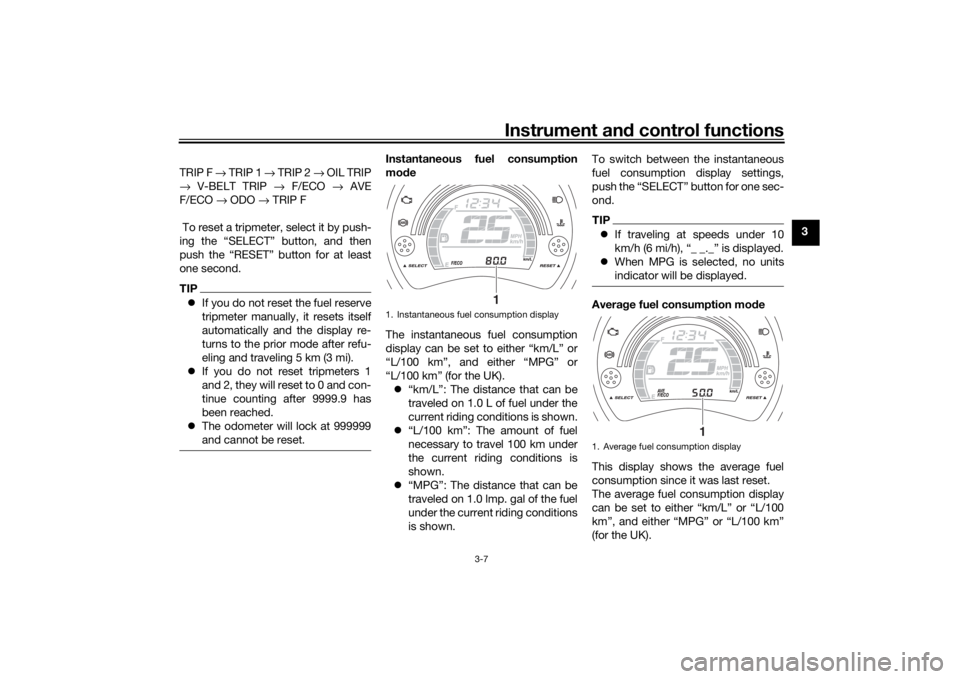
Instrument and control functions
3-7
3
TRIP F
→ TRIP 1 → TRIP 2 → OIL TRIP
→ V-BELT TRIP → F/ECO → AVE
F/ECO → ODO → TRIP F
To reset a tripmeter, select it by push-
ing the “SELECT” button, and then
push the “RESET” button for at least
one second.
TIP If you do not reset the fuel reserve
tripmeter manually, it resets itself
automatically and the display re-
turns to the prior mode after refu-
eling and traveling 5 km (3 mi).
If you do not reset tripmeters 1
and 2, they will reset to 0 and con-
tinue counting after 9999.9 has
been reached.
The odometer will lock at 999999
and cannot be reset.
Instantaneous fuel consumption
mo de
The instantaneous fuel consumption
display can be set to either “km/L” or
“L/100 km”, and either “MPG” or
“L/100 km” (for the UK). “km/L”: The distance that can be
traveled on 1.0 L of fuel under the
current riding conditions is shown.
“L/100 km”: The amount of fuel
necessary to travel 100 km under
the current riding conditions is
shown.
“MPG”: The distance that can be
traveled on 1.0 lmp. gal of the fuel
under the current riding conditions
is shown. To switch between the instantaneous
fuel consumption display settings,
push the “SELECT” button for one sec-
ond.
TIP
If traveling at speeds under 10
km/h (6 mi/h), “_ _._” is displayed.
When MPG is selected, no units
indicator will be displayed.Avera ge fuel consumption mo de
This display shows the average fuel
consumption since it was last reset.
The average fuel consumption display
can be set to either “km/L” or “L/100
km”, and either “MPG” or “L/100 km”
(for the UK).
1. Instantaneous fuel consumption display
1
1. Average fuel consumption display
1
U2DSE0E0.book Page 7 Thursday, March 19, 2015 10:34 AM
Page 24 of 90
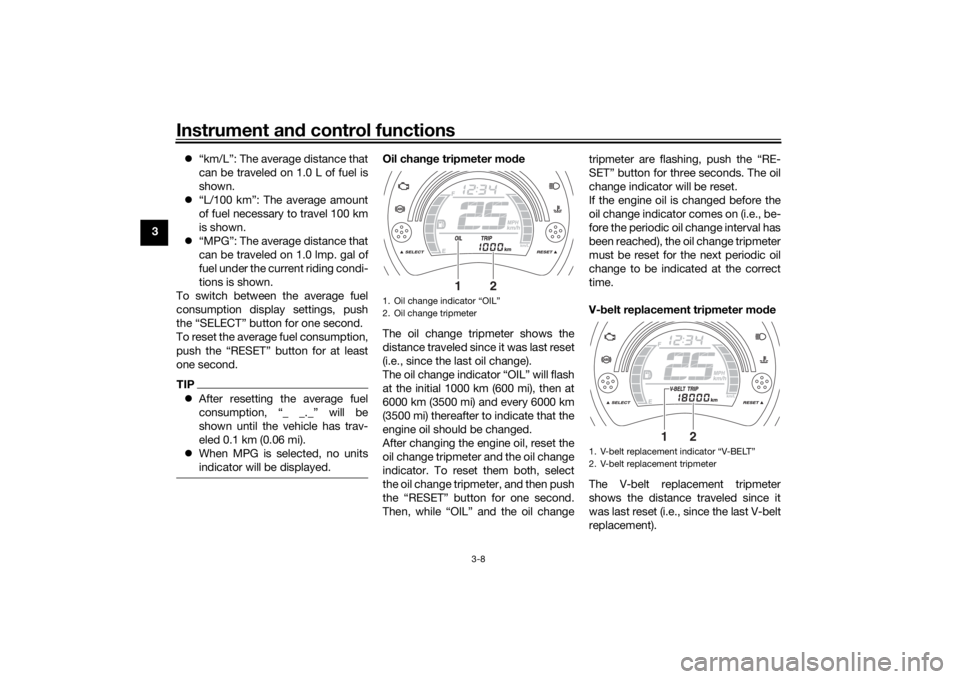
Instrument and control functions
3-8
3
“km/L”: The average distance that
can be traveled on 1.0 L of fuel is
shown.
“L/100 km”: The average amount
of fuel necessary to travel 100 km
is shown.
“MPG”: The average distance that
can be traveled on 1.0 lmp. gal of
fuel under the current riding condi-
tions is shown.
To switch between the average fuel
consumption display settings, push
the “SELECT” button for one second.
To reset the average fuel consumption,
push the “RESET” button for at least
one second.
TIP After resetting the average fuel
consumption, “_ _._” will be
shown until the vehicle has trav-
eled 0.1 km (0.06 mi).
When MPG is selected, no units
indicator will be displayed.
Oil chan ge tripmeter mo de
The oil change tripmeter shows the
distance traveled since it was last reset
(i.e., since the last oil change).
The oil change indicator “OIL” will flash
at the initial 1000 km (600 mi), then at
6000 km (3500 mi) and every 6000 km
(3500 mi) thereafter to indicate that the
engine oil should be changed.
After changing the engine oil, reset the
oil change tripmeter and the oil change
indicator. To reset them both, select
the oil change tripmeter, and then push
the “RESET” button for one second.
Then, while “OIL” and the oil change tripmeter are flashing, push the “RE-
SET” button for three seconds. The oil
change indicator will be reset.
If the engine oil is changed before the
oil change indicator comes on (i.e., be-
fore the periodic oil change interval has
been reached), the oil change tripmeter
must be reset for the next periodic oil
change to be indicated at the correct
time.
V-
belt replacement tripmeter mod e
The V-belt replacement tripmeter
shows the distance traveled since it
was last reset (i.e., since the last V-belt
replacement).1. Oil change indicator “OIL”
2. Oil change tripmeter
2
1
1. V-belt replacement indicator “V-BELT”
2. V-belt replacement tripmeter
2
1
U2DSE0E0.book Page 8 Thursday, March 19, 2015 10:34 AM
Page 28 of 90

Instrument and control functions
3-12
3
EAU66690
Fuel tank capTo remove the fuel tank cap
Open the fuel tank cap lock cover, in-
sert the key into the lock, and then turn
it 1/4 turn clockwise. The lock will be
released and the fuel tank cap can be
removed.
To install the fuel tank cap
1. Insert the fuel tank cap into the tank opening with the key inserted
in the lock and with the “ ” mark
facing forward. 2. Turn the key counterclockwise to
the original position, remove it,
and then close the lock cover.
TIPThe fuel tank cap cannot be installed
unless the key is in the lock. In addi-
tion, the key cannot be removed if the
cap is not properly installed and
locked.
WARNING
EWA10132
Make sure that the fuel tank cap is
properly installe d before ri din g.
Leakin g fuel is a fire hazar d.
1. Front wheel sensor
2. Front wheel sensor rotor
1. Rear wheel sensor
2. Rear wheel sensor rotor
2
1
1
2
1. Fuel tank cap lock cover
2. Lock.
3. Unlock.
1 2
3
1. “ ” mark
1
U2DSE0E0.book Page 12 Thursday, March 19, 2015 10:34 AM
Page 29 of 90
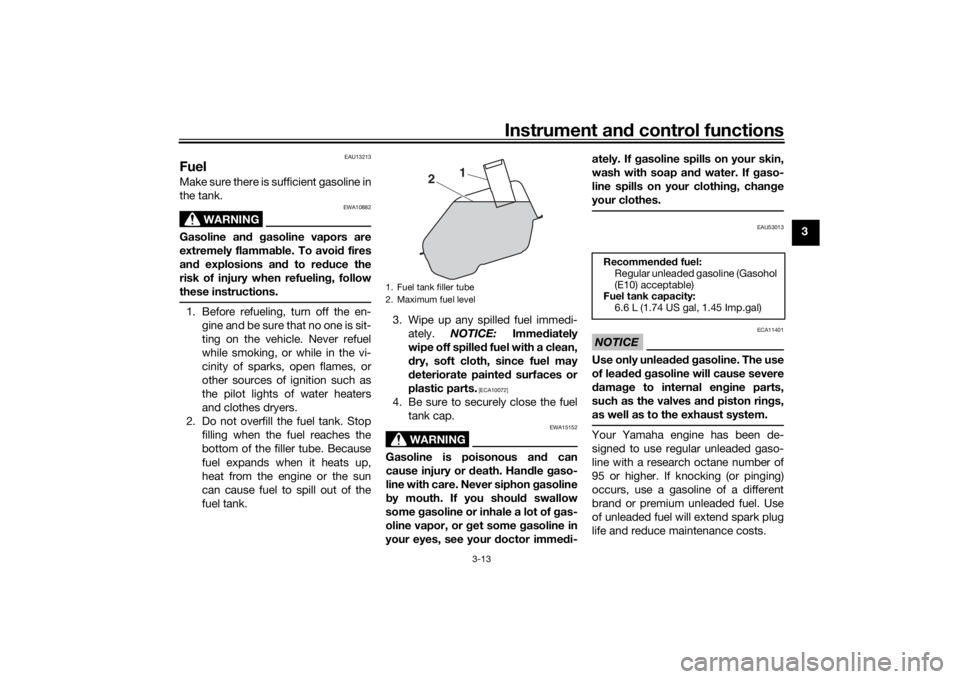
Instrument and control functions
3-13
3
EAU13213
FuelMake sure there is sufficient gasoline in
the tank.
WARNING
EWA10882
Gasoline an d gasoline vapors are
extremely flammab le. To avoid fires
an d explosions an d to re duce the
risk of injury when refuelin g, follow
these instructions.1. Before refueling, turn off the en- gine and be sure that no one is sit-
ting on the vehicle. Never refuel
while smoking, or while in the vi-
cinity of sparks, open flames, or
other sources of ignition such as
the pilot lights of water heaters
and clothes dryers.
2. Do not overfill the fuel tank. Stop filling when the fuel reaches the
bottom of the filler tube. Because
fuel expands when it heats up,
heat from the engine or the sun
can cause fuel to spill out of the
fuel tank. 3. Wipe up any spilled fuel immedi-
ately. NOTICE: Immediately
wipe off spille d fuel with a clean,
d ry, soft cloth, since fuel may
d eteriorate painte d surfaces or
plastic parts.
[ECA10072]
4. Be sure to securely close the fuel tank cap.
WARNING
EWA15152
Gasoline is poisonous an d can
cause injury or d eath. Handle gaso-
line with care. Never siphon gasoline
b y mouth. If you shoul d swallow
some gasoline or inhale a lot of gas-
oline vapor, or g et some gasoline in
your eyes, see your doctor imme di- ately. If g
asoline spills on your skin,
wash with soap an d water. If gaso-
line spills on your clothin g, chan ge
your clothes.
EAU53013
NOTICE
ECA11401
Use only unlea ded g asoline. The use
of lead ed g asoline will cause severe
d amag e to internal en gine parts,
such as the valves an d piston rin gs,
as well as to the exhaust system.Your Yamaha engine has been de-
signed to use regular unleaded gaso-
line with a research octane number of
95 or higher. If knocking (or pinging)
occurs, use a gasoline of a different
brand or premium unleaded fuel. Use
of unleaded fuel will extend spark plug
life and reduce maintenance costs.
1. Fuel tank filler tube
2. Maximum fuel level
2 1
Recommen
ded fuel:
Regular unleaded gasoline (Gasohol
(E10) acceptable)
Fuel tank capacity:
6.6 L (1.74 US gal, 1.45 Imp.gal)
U2DSE0E0.book Page 13 Thursday, March 19, 2015 10:34 AM
Page 30 of 90
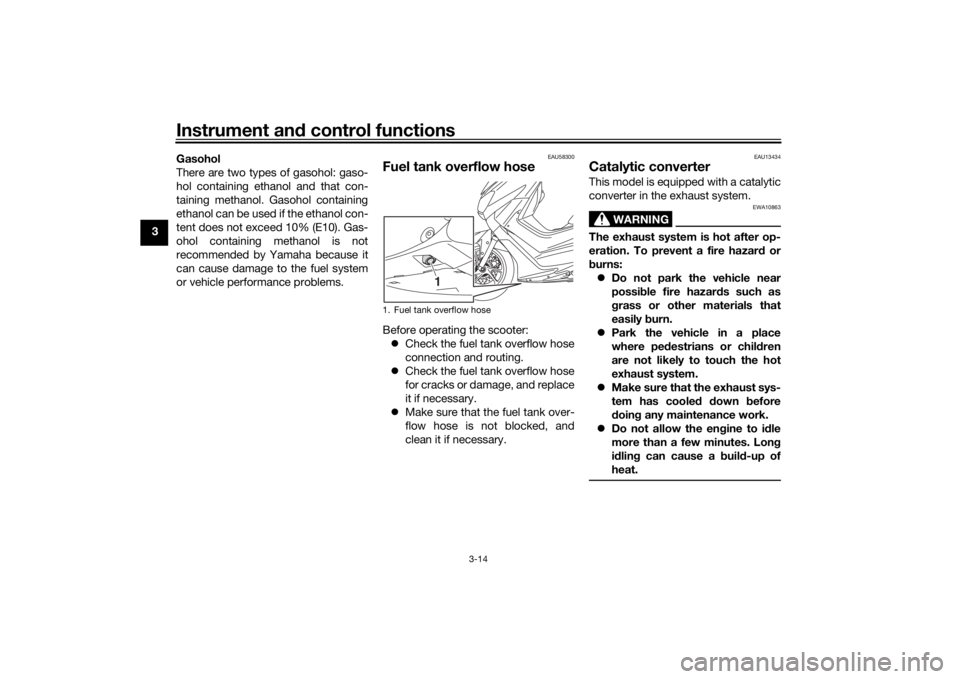
Instrument and control functions
3-14
3 Gasohol
There are two types of gasohol: gaso-
hol containing ethanol and that con-
taining methanol. Gasohol containing
ethanol can be used if the ethanol con-
tent does not exceed 10% (E10). Gas-
ohol containing methanol is not
recommended by Yamaha because it
can cause damage to the fuel system
or vehicle performance problems.
EAU58300
Fuel tank overflow hoseBefore operating the scooter:
Check the fuel tank overflow hose
connection and routing.
Check the fuel tank overflow hose
for cracks or damage, and replace
it if necessary.
Make sure that the fuel tank over-
flow hose is not blocked, and
clean it if necessary.
EAU13434
Catalytic converterThis model is equipped with a catalytic
converter in the exhaust system.
WARNING
EWA10863
The exhaust system is hot after op-
eration. To prevent a fire hazar d or
b urns:
Do not park the vehicle near
possi ble fire hazard s such as
g rass or other materials that
easily burn.
Park the vehicle in a place
where ped estrians or chil dren
are not likely to touch the hot
exhaust system.
Make sure that the exhaust sys-
tem has coole d down before
d oin g any maintenance work.
Do not allow the en gine to i dle
more than a few minutes. Lon g
i d lin g can cause a b uild-up of
heat.
1. Fuel tank overflow hose
1
U2DSE0E0.book Page 14 Thursday, March 19, 2015 10:34 AM